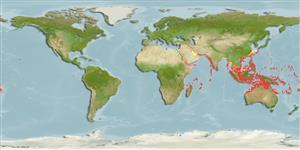分类 / Names
俗名 | 同种异名 | Catalog of Fishes(属, 种) | ITIS | CoL | WoRMS | Cloffa
Teleostei >
Eupercaria/misc (Various families in series Eupercaria)
鱸形目 (Various families in series Eupercaria) >
Labridae (Wrasses)
隆頭魚科 (Wrasses) > Cheilininae
Etymology: Cheilinus: Greek, cheilos = lip (Ref. 45335).
More on author: Rüppell.
Environment: milieu / climate zone / depth range / distribution range
生态学
海洋 礁区鱼类; 深度上下限 0 - 100 m (Ref. 58652). 热带; 30°N - 23°S
Indo-Pacific: Red Sea to South Africa (Ref. 35918) and to the Tuamoto Islands, north to the Ryukyu Islands, south to New Caledonia. Formerly known as Vulnerable (A1d+2cd) (Y. Sadovy) but now listed as Endangered in IUCN 2004.
印度-太平洋: 红海到南非 (参考文献 35918) 与到 Tuamoto 岛, 北至琉球群岛, 南至新加勒多尼亚。 过去称为次级保育类动物 (1d+2 cd)(Y. Sadovy) 但是现在列出的当濒临绝种的在 IUCN 2004 与列出在 CITES 的附录 2。
Length at first maturity / 大小 / 重量 / 年龄
Maturity: Lm ?, range 52 - ? cm
Max length : 229 cm SL 雄鱼/尚未辨别雌雄; (Ref. 9823); common length : 60.0 cm TL 雄鱼/尚未辨别雌雄; (Ref. 5450); 最大体重: 191.0 kg (Ref. 9710); 最大年龄: 32 年 (Ref. 51676)
背棘 (总数) : 9; 背的软条 (总数) : 10; 臀棘: 3; 臀鳍软条: 8. This species is distinguished by the following characters: body deep, its depth 2.2-2.7 times in standard length; dorsal profile of head straight to above eye, then becoming convex; adults develop a large hump on forehead that can protrude anterior to eye; anterior tip of head forming an acute angle; jaws and lips prominent, 2 strong canines anteriorly in each jaw; no enlarged tooth present of rear of upper jaw; D IX,10, continuous; A III,8; dorsal and anal fins of adults very pointed, reaching well posterior to caudal-fin base; pelvic fins of small fish reaching anus, extending beyond anal-fin origin in large adults; pectoral fins with ii unbranched and 10 branched rays; caudal fin rounded; lateral line interrupted below posterior portion of dorsal-fin base, with a total of 22-23 pored scales; scales reaching well onto bases of dorsal and anal fins; scales in front of dorsal fin extending forward to above centre of eye; cheek and opercle scaly; lower jaw without scales. Colour of body olive to green with a vertical dark bar on each scale above and behind pectoral fins; head of adults blue-green to blue with highly irregular undulating yellowish lines; 2 black lines extending posteriorly from eye. Juvenile coloration lighter to white with dark scale bars and prominent black lines extending posteriorly from eyes, as well as 2 lines extending diagonally up and back from eye and 2 diagonally downward on snout in front of eye (Ref. 9823).
这种的成鱼在前额上发育厚唇与一个突出的凸起隆起。 稚鱼灰白的呈绿色的在渐渐地形成横带的鳞片上有细长的深色斑点; 2条黑色的线在后部地从眼.(参考文献 4392)
Adults inhabit steep outer reef slopes, channel slopes, and lagoon reefs (Ref. 1602). They are benthopelagic at 2-60 m (Ref. 58302). They are usually solitary but may occur in pairs. Juveniles are encountered in coral-rich areas of lagoon reefs, where staghorn Acropora corals abound (Ref. 1602) and also in algae reefs or seagrasses (Ref. 48636, 41878). Adults rove across the reefs by day and rest in reef caves and under coral ledges at night (Ref. 31343). Primary food are mollusks, fishes, sea urchins, crustaceans, and other invertebrates. They are one of the few predators of toxic animals such as sea hares, boxfishes and crown-of-thorns starfish (Ref. 1602). They are oviparous with distinct pairing during breeding (Ref. 205). They are sold in Hong Kong live fish markets (Ref. 27253). This species is captured by hook-and-line and by spear, and is occasionally marketed for food. Juveniles are occasionally seen in the aquarium trade (Ref. 9823). Minimum depth reported taken from Ref. 128797.
栖息于陡峭的外礁斜坡,峡道斜坡与泻湖礁。 通常独居性的但是可能成对出现。 稚鱼在泻湖礁的珊瑚礁繁盛区域中被见到, 在哪里充满鹿角 Acropora 珊瑚;(参考文献 1602) 也在藻类礁或海草中.(参考文献 48636) 成鱼白天巡游于礁之间而且在礁洞穴中休息与在珊瑚岩架下面在晚上.(参考文献 31343) 初期的食物是软件动物,鱼,海胆,甲壳动物与其他的无脊椎动物。 一那少数有毒动物例如海兔,箱 与刺冠海星的掠食者.(参考文献 1602) 发现于了香港活鱼贩售。 (参考文献 27253)
Life cycle and mating behavior
Maturities | 繁殖 | Spawnings | Egg(s) | Fecundities | 仔鱼
Oviparous, distinct pairing during breeding (Ref. 205). Also Ref. 103751.印度-太平洋: 红海到南非 (参考文献 35918) 与到 Tuamoto 岛, 北至琉球群岛, 南至新加勒多尼亚。 过去称为次级保育类动物 (1d+2 cd)(Y. Sadovy) 但是现在列出的当濒临绝种的在 IUCN 2004 与列出在 CITES 的附录 2。
Randall, J.E., G.R. Allen and R.C. Steene, 1990. Fishes of the Great Barrier Reef and Coral Sea. University of Hawaii Press, Honolulu, Hawaii. 506 p. (Ref. 2334)
世界自然保护联盟红皮书 (Ref. 130435)
濒危 (EN) (A2bd+3bd); Date assessed: 30 April 2004
人类利用
渔业: 低经济; 养殖: 商业性; 游钓鱼种: 是的; 水族馆: 商业性
工具
特别资料
下载 XML
网络资源
Estimates based on models
Preferred temperature (Ref.
123201): 24.9 - 28.8, mean 27.5 °C (based on 580 cells).
Phylogenetic diversity index (Ref.
82804): PD
50 = 0.5078 [Uniqueness, from 0.5 = low to 2.0 = high].
Bayesian length-weight: a=0.01514 (0.01169 - 0.01959), b=2.97 (2.90 - 3.04), in cm total length, based on LWR estimates for this species (Ref.
93245).
营养阶层 (Ref.
69278): 4.0 ±0.61 se; based on food items.
Generation time: 27.5 ( na - na) years. Estimated as median ln(3)/K based on 2
growth studies.
回复力 (Ref.
120179): 低的, 最小族群倍增时间4.5 - 14 年 (tm = 5-7; tmax = 32).
Fishing Vulnerability (Ref.
59153): High to very high vulnerability (74 of 100).
Nutrients (Ref.
124155): Calcium = 12.1 [5.8, 27.5] mg/100g; Iron = 0.416 [0.172, 0.952] mg/100g; Protein = 18.1 [13.7, 21.4] %; Omega3 = 0.0801 [, ] g/100g; Selenium = 63.5 [27.0, 158.4] μg/100g; VitaminA = 100 [16, 448] μg/100g; Zinc = 1.77 [1.00, 3.02] mg/100g (wet weight); based on
nutrient studies.
